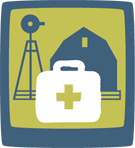Farm Emergency Preparedness Planning

|
Protecting your farm involves a number of considerations – family members, co-workers or employees, buildings, equipment, livestock, and crops. Planning ahead for all-hazard situations can help to minimize the impact and speed the recovery process for you and your farm. Use this checklist to prepare your family before a disaster situation. |
Before a Disaster or Emergency
Gather information.
- What disasters or hazards are most likely in your community? For your farm?
- How would you be warned?
- How should you prepare for each?
Know the warning signals for your area.
- Learn the warning systems for your community.
- Are you able to hear or see the appropriate warning from your farm?
Stay alert for emergency broadcasts.
- Emergency Alert System broadcasts on radio or television
- NOAA weather radio alerts
- News sources – radio, television, internet
Put together an emergency supply kit for your family.
- See ‘Family Emergency Supply Kit’ handout
Draw a farm site map and indicate:
- Buildings and structures
- Access routes (e.g., roads, lanes)
- Barriers (fences, gates)
- Locations of livestock
- Locations of all hazardous substances
- Electrical shutoff locations, etc.
Make a list of your farm inventory, include:
- Livestock (species, number of animals)
- Crops (acres, type)
- Machinery and equipment (make, model #)
- Hazardous substances (e.g., pesticides, fertilizers, fuels, medicines, other chemicals)
Keep a list of emergency phone numbers.
- Your local and state veterinarian
- County extension service
- Local emergency management
- Insurance agent
Make a list of suppliers or businesses providing services to your farm.
- Livestock or milk transport, feed delivery, fuel delivery, etc.
Contact your insurance agent.
- Review your insurance coverage.
- Get additional coverage for “all-hazard” situations (e.g., flood, hail damage).
Stockpile supplies needed to protect the farm:
- Sandbags and plastic sheeting, in case of flood
- Wire and rope to secure objects
- Lumber and plywood to protect windows
- Extra fuel for tractors and vehicles
- Hand tools for preparation and recovery
- Fire extinguishers in all barns and all vehicles
- A safe supply of food to feed livestock
- A gas powered generator
Identify areas (e.g., higher elevation) to relocate your assets, if needed.
- Livestock and horses
- Equipment
- Feed, grain, hay
- Agrochemicals ( pesticides, herbicides)
Remove or secure any loose equipment or materials, such as lumber or fuel tanks.
Prepare farm employees.
- Keep them informed of the farm’s emergency plan; review it with them regularly.
- Identify shelter-in-place or evacuation locations.
- Establish a phone tree with contact information for all employees.
Important Websites
Website with resources to learn how to protect your animals in disaster and emergency situations.
U.S. Department of Agriculture, National Agricultural Library
Website with information on preparing for disasters, including what to include in your emergency supply kit.
Centers for Disease Control and Prevention (CDC)
Downloadable templates to use for developing a Family Emergency Plan.
Federal Emergency Management Agency (FEMA)
Website of information and resources to help you and your family get prepared for disaster situations.
Federal Emergency Management Agency and Citizens Corps
Additional Preparedness Resources
An independent study course to increase awareness and preparedness of animal owners to reduce the impact of disasters on animals.
Federal Emergency Management Agency (FEMA)
An interactive web-based course to guide emergency management officials, animal owners, and animal care providers in preparing community disaster plans.
Federal Emergency Management Agency (FEMA)
FEMA's comprehensive guidebook on individual, family, and community disaster preparedness.
Federal Emergency Management Agency (FEMA)
Factsheet on measures to take to care for your animals after a disaster.
Colorado State University Extensioni
Factsheet on measures to take to prepare your animals before disaster situations.
Colorado State University Extension
Factsheet on measures to take to protect your animals during a disaster situation.
Colorado State University Extension
Factsheet with information to help small ruminant owners prepare for all types of disasters.
Louisiana State University Ag Center
Factsheet (2 pages) to help horse producers prepared for all types of disasters.
Louisiana State University Ag Center
Factsheet (2 pages) to help beef producers prepared for disasters of all types.
Louisiana State University Ag Center
Factsheet (2 page) to help dairy producers prepare their farm and herd for disaster situations.
Louisiana State University Ag Center
Website with information on evacuating prior to a disaster and measures to take to stay safe.
Federal Emergency Management Agency (FEMA)
Website with links to information on various health and safety issues that can occur during or after disaster situations
Centers for Disease Control and Prevention (CDC)
Booklet (16 pages) containing detailed disaster planning information for small and large animals.
American Veterinary Medical Association (AVMA)






